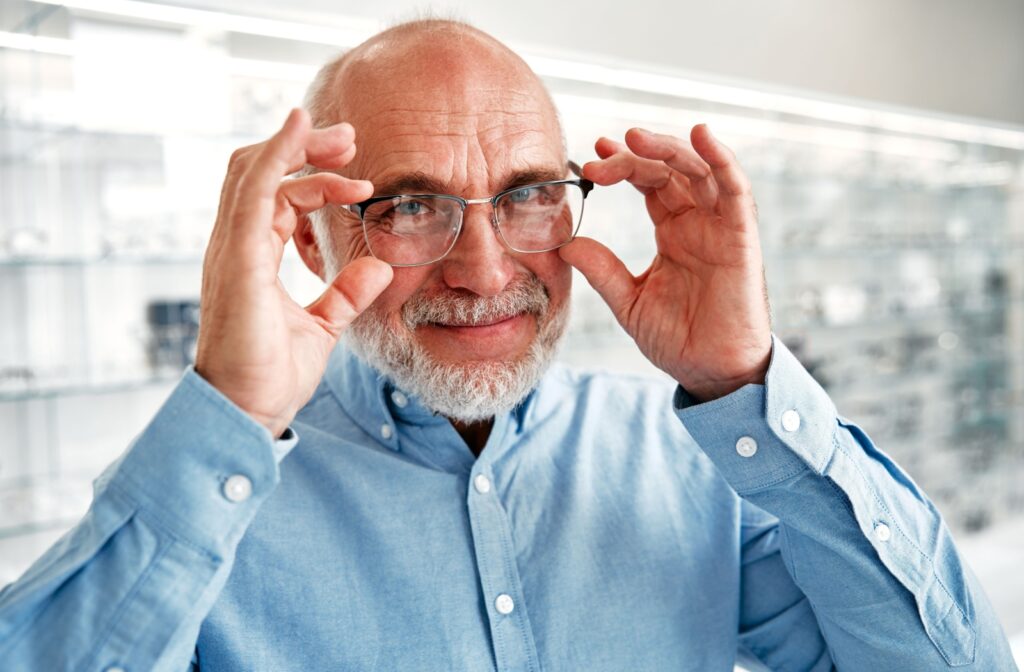Our eyes are some of the hardest-working muscles in our bodies. From scanning spreadsheets to reading books, they’re constantly on the move. However, when you spend too long focusing, you might notice symptoms like headaches and blurry vision.
That’s eye strain, an extremely common problem. So what can you do?
For adults whose eye strain is a result of presbyopia, reading glasses may help. They correct light as it enters the eye, making focusing your eyes significantly easier.
You can also incorporate regular breaks, adjust lighting, and make other small changes to your routine to reduce the risk of developing eye strain.
Our eye care team can provide more personalized tips to help you experience comfortable vision at your next eye exam.
What Is Eye Strain?
Your eyes use tiny muscles to focus and control themselves. These work closely with one another to let you properly move your eyes and lens. However, they’re like any other muscle in your body—if you use them too much, they need a break.
Think of the last time you carried something heavy—if you hold it for too long, your muscles ache. Similarly, when you hold the same position with your eyes, constantly working to focus on the same task, your eyes can feel the same way. This is eye strain.
While any prolonged or intense vision task can cause strain, digital strain or computer vision syndrome is the most common form. Digital eye strain is typically caused by extended screen use or reading for hours without a break.
Common Signs of Eye Strain
Any activity that requires intense focus has the potential to strain your eyes. Some are everyday tasks you might not even think twice about.
Here are a few of the most common symptoms of eye strain:
- Blurred or double vision
- Headaches or migraines
- Watery, burning, or dry eyes
- Light sensitivity
- Neck, shoulder, or back pain
- Difficulty focusing or eye fatigue
These symptoms are usually temporary, as long as you take a break. If you stay focused intensely on your task, the symptoms could worsen.
Does Eye Strain Get More Common with Age?
Your eye has a natural lens just behind the cornea. When you focus on something at different distances, this lens changes shape. It’s a small, clear, flexible part of your eye.
However, the lens becomes less elastic over time. It struggles to effectively change shape, especially for close-up tasks. The condition is called presbyopia. It’s a common, age-related condition, typically causing symptoms around age 45.
How Reading Glasses Help with Eye Strain
When presbyopia is a problem, reading glasses shine. Reading glasses help reduce the effort needed to focus on nearby objects. The lenses support the lens in altering light as it enters the eye to focus accurately on the retina.
But reading glasses don’t just help with presbyopia. They can also be effective for eye strain caused by close-work tasks. Since the glasses make it easier to focus on nearby objects, they take away some of the effort that otherwise could lead to strain.
What to Look for in a Pair of Reading Glasses
Not all reading glasses are created equal. The right pair for you will depend on your unique needs. Choosing wisely now can save you a lot of time and effort later.
Here are some tips for finding an ideal pair of reading glasses:
- Determine the correct lens strength based on your vision needs
- Select durable frames that suit your style & preference
- Consider anti-glare or blue-light-blocking options for screen comfort
- Test the fit to confirm they sit comfortably on your face
If you don’t know your prescription or need personalized tips, visit your optometrist. They can perform an eye exam to diagnose the underlying cause of your symptoms. Then, their eye care team can help you pick a pair that suits your specific needs to help you with presbyopia and strain.

Simple Tips for Preventing Eye Strain
However, aging isn’t the only cause of strained eyes. Reading glasses may not be effective when lifestyle factors or unrelated eye conditions cause your eye discomfort.
Fortunately, if your daily habits cause eye strain, introducing good habits and minor adjustments can help.
Here are some easy tips to ease the burden on your eyes:
- Follow the 20-20-20 rule, taking a break every 20 minutes to focus on something 20 feet away for 20 seconds
- Arrange your workspace for eye comfort, adjusting your computer screen so it’s at eye level with minimal glare
- Maintain a well-lit working space, avoiding harsh overhead lights or dim areas where you need to strain to see clearly
- Blink often to keep your eyes moist & refreshed, especially during screen time
These small actions can have a significant impact. Giving your eyes a much-needed break can help keep them comfortable.
Get Personalized Advice for Reading Glasses Today
Eye strain shouldn’t hold you back from your favorite hobbies or work. Whether you’re reading, knitting, or poring over reports, reading glasses may be a simple way to help. However, don’t forget about the value of a proper eye exam! At Pine Creek Vision Clinic, we can help you find effective ways to keep your vision comfortable and healthy. We can examine your eyes, help diagnose the root cause of your symptoms, and give you the personalized advice you deserve. Book an appointment with us today to learn more!



